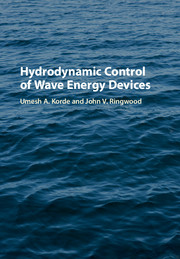Book contents
- Frontmatter
- Contents
- Preface
- Acknowledgments
- Part I Introduction
- Part II The Basics
- Part III The Hydrodynamics
- 5 Nature of the Wave Input
- 6 A Closer Look at Wave Energy Hydrodynamics
- Part IV Velocity Control Using a Hydrodynamic Model
- Part V Control by Optimizing a Performance Index
- Part VI Toward Overall WEC System Hydrodynamic Optimization
- Part VII In Closing
- References
- Index
5 - Nature of the Wave Input
from Part III - The Hydrodynamics
Published online by Cambridge University Press: 05 September 2016
- Frontmatter
- Contents
- Preface
- Acknowledgments
- Part I Introduction
- Part II The Basics
- Part III The Hydrodynamics
- 5 Nature of the Wave Input
- 6 A Closer Look at Wave Energy Hydrodynamics
- Part IV Velocity Control Using a Hydrodynamic Model
- Part V Control by Optimizing a Performance Index
- Part VI Toward Overall WEC System Hydrodynamic Optimization
- Part VII In Closing
- References
- Index
Summary
A sound understanding of the type of energy resource a wave energy device must convert can be developed if we confine ourselves to “small amplitude” waves, that is, waves for which the crest-to-trough height is small enough compared with the length of the wave (i.e., the distance separating like points (such as crests/troughs) on the wave) so that the height-to-length ratio or, in a sense, the “wave slope,” can be assumed to be very small. A quantitative description of a seemingly random or irregular wave field is then possible to build using a quantitative description of harmonic (i.e., monochromatic or single-frequency) waves. Next, if the response of the wave energy device to such a wave is understood, and if the device is thought to respond like a linear system, then the response to an irregular wave can be reproduced via linear superposition. The focus of this chapter is on developing an understanding of complex, irregular wave patterns, preparatory to understanding the response and performance of a wave energy device in such waves.
Description of a Harmonic Wave
Our study begins with a description of a harmonic wave of single frequency and single amplitude. Excellent coverage of this topic can be found in [1, 3, 4, 6, 8, 65, 66, etc.]. We recall from before that in deep water the water particles under a regular wave move in circular orbits whose radii decrease rapidly with depth. Our immediate goal below is to obtain a quantitative understanding of regular waves. Later in this chapter, we will extend this to irregular waves more representative of what we find in the real ocean. Fig. 5.1 shows an illustration of a regular wave.
Wave action on the water surface is largely the combined effect of external forcing such as wind and a restoring force generated by the water body. For waves relevant to energy conversion, the restoring action is provided by gravity. Furthermore, the waves we really want to utilize have small amplitudes or, more precisely, have small slopes, in that their height-to-length ratio is less than an order of magnitude smaller than unity. This enables an analysis based on linear differential equations, allowing for the use of linear superposition throughout. It has been well observed, however, that this assumption of linearity does in general lead to meaningful results of practical applicability.
- Type
- Chapter
- Information
- Hydrodynamic Control of Wave Energy Devices , pp. 91 - 112Publisher: Cambridge University PressPrint publication year: 2016



